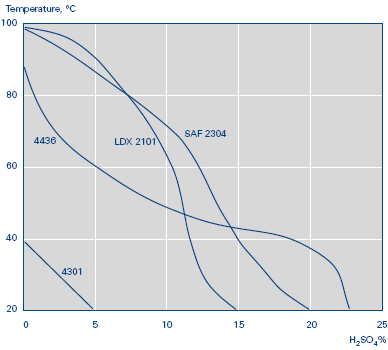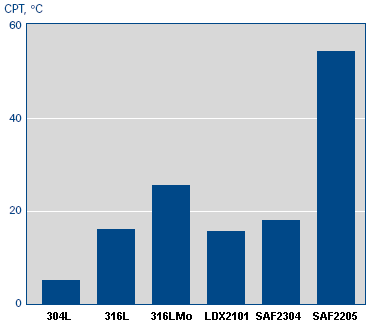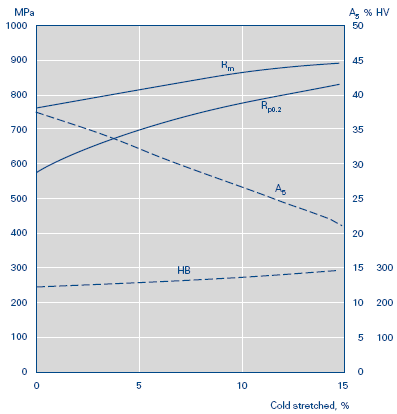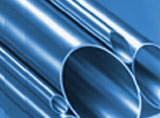Glossary of Terms
Age Hardening
Martensitic stainless steels are hardened by heating above their critical temperature, holding them at heat to insure uniform temperature, and cooling them rapidly by quenching in air or oil.
Alloying Element
The adding of any metallic element in stainless steel production in order to increase hardness, strength, or corrosion resistance. Molybdenum, nickel, and chromium are common alloying elements in stainless steel.
Alloy Surcharge
The producer’s selling price plus a surcharge added to offset the increasing costs of raw materials caused by increasing alloy prices.
Annealing (Solution Annealing)
A process of heating cold stainless steel to obtain maximum softness and ductility by heat treatment which also produces a homogeneous structure (in austenitic grades) or a 50/50 mixture of austenite and ferrite (in duplex grades). It relieves stresses that have built up during cold working and insures maximum corrosion resistance. Annealing can produce scale on the surface that must be removed by pickling.
Austenitic Stainless Steel
Non-magnetic stainless steels that contain nickel and chromium sufficient to develop and retain the austenitic phase at room temperature. Austenitic stainless steels are the most widely used category of stainless steel.
 Centerless Grinding
Centerless Grinding
An operation whereby the surface of a bar is ground without using a lathe.
Chloride Stress Corrosion Cracking
Cracking due to the combination of tensile stress and corrosion in the presence of water and chlorides.
Chromium (Cr)
An alloying element that is used in stainless steel to deter corrosion.
Cold Finished Bars
Hot rolled stainless steel bars that are annealed and cold worked to produce a higher surface quality and higher strength.
Cold Forming (Cold Working)
Any mechanical operation that creates permanent deformation, such as bending, rolling, drawing, etc., performed at room temperature that increases the hardness and strength of the stainless steel.
Continuous Casting
Processes of pouring stainless steel into a billet, bloom, or slab directly from the furnace. This process avoids the need for large, expensive mills and also saves time because the slabs solidify in minutes rather than the several hours it takes for an ingot to form.
Corrosion
The attack upon metals by chemical agents converting them to non-metallic products. Stainless steel has a passive film created by the presence of chromium (and often other alloying elements – nickel, molybdenum) that resists this process.
Corrosion Fatigue
Cracking due to repeating and fluctuating stresses in a corrosive environment.
Corrosion Resistance
A metal’s ability to resist corrosion in a particular environment.
Crevice Corrosion
Corrosion of stainless steel on the surface that is fully shielded from air such that the passive film cannot be created to resist the corrosion.
Cut-to-Length
Cutting flat-rolled stainless steel into desired length and then normally shipping it flat-stacked.
 Duplex
Duplex
Stainless steel comprised of austenitic and ferritic stainless steels that contain high amounts of chromium and nickel. This combination is stronger than both of the inpidual stainless steels. Duplex stainless steels are highly resistant to corrosion and cracking.
 Elongation
Elongation
A measurement of ductility expressed in terms of the stretch having occurred over a given length on a standard tensile specimen at time of fracture, usually based upon an original length of 2 inches.
Erosion-Corrosion
An accelerated loss of material concerning corrosion and erosion that results from corrosive material interacting with the material.
 Fabricator
Fabricator
An intermediate product producer that purchases materials and processes them specifically for a particular project.
Fatigue
A condition leading to the eventual fracture of a material due to constant or repeated stresses that exert less pressure than the tensile strength of the material.
Ferrite
The body-centered cubic crystalline phase of iron-based alloys.
Ferritic
Magnetic stainless steels that have a low carbon content and contain chromium as the main alloying element, usually between 13% and 17%. It is the second most widely used stainless steel. Ferritic stainless steels are generally used in automotive trim and exhaust systems, hot water tanks, and interior architectural trim.
Ferroalloy
Metal products such as ferrochrome, ferromanganese, and ferrosilicon that are commonly used as raw materials to aid various stages in stainless steel making.
Ferrochrome
A common raw material in stainless steel production. This alloy consists of iron and up to 72% chromium.
Finish
The final condition of the surface after the last phase of production.
Finishing Facilities
These facilities process semi-finished stainless steel into ready-made forms that can be used by others. Some facilities are rolling mills, pickle lines, tandem mills, annealing facilities, and temper mills.
Flat-Rolled Stainless Steel (Flat Product)
Category of stainless steel that includes shapes such as sheet, strip, and plate.
Forming
A process that brings about a change in the shape of stainless steel by the application of force (i.e. cold forming, hot forming, wire forming).
Free-Machining
A stainless steel to which a small amount of some relatively insoluble element (such as sulfur, selenium) is added to create a minute and widely distributed soft phase that acts as chip breakers during machining.
 Galvanic Corrosion
Galvanic Corrosion
Accelerated corrosion of a metal because of an electrical contact with a more noble metal or non-metallic conductor in a corrosive electrolyte.
Gauge
The thickness of a certain stainless steel.
General Corrosion
General corrosion is the term used to describe the attack that proceeds in a relatively uniform manner over the entire surface of a metal. Typically, stainless steels do not exhibit general corrosion.
 Heat Treatment
Heat Treatment
Altering the properties of stainless steel by subjecting it to a series of temperature changes. To increase the hardness, strength, or ductility of stainless steel so that it is suitable for additional applications.
Hot Forming
Hot forming operations are used widely in the fabrication of stainless steel to take advantage of their lower resistance to shape change. High temperature reduces their yield strengths, and this results in a marked lowering of the force that is required to bring about plastic movement or flow from one shape to another (hot rolling, hot stretching, etc.).
 Impact Test
Impact Test
Impact testing is used to measure the toughness of a material, corresponding to the energy necessary to cause fracture under shock loading. Low toughness is generally associated with brittle shear fracture and high toughness with ductile plastic tearing.
Intergranular Corrosion
Preferential corrosion cracking at or along the grain boundaries of a metal.
Intergranular Stress Corrosion Cracking
Stress corrosion cracking in which the cracking occurs along grain boundaries.
 Life Cycle Costing
Life Cycle Costing
An accounting method of costing where expenses are allocated over the life of the product. Life cycle costs are often lower for stainless steel than for alternatives despite a higher initial outlay because stainless products generally last longer and require little maintenance.
Long Products
Category of stainless steel that includes rods, bars, and structural products that are described as long rather than flat.
Low-Carbon Stainless Steel
Stainless steel containing less than 0.03% carbon.
 Martensite
Martensite
A hard supersaturated solid solution of iron characterized by an acicular (needle-like) microstructure.
Martensitic
A small category of magnetic stainless steels typically containing 12% chromium, a moderate level of carbon, and a very low level of nickel.
Mechanical Properties (Physical Properties)
Properties determined by mechanical testing, such as yield strength, ductility, ultimate tensile strength, hardness, bendability, impact strength, etc.
Molybdenum (Mo)
An alloying element that enhances corrosion resistance along with chromium in stainless steels.
 Nickel (Ni)
Nickel (Ni)
An alloying element used in stainless steels to enhance ductility and corrosion resistance.
Nickel-Based Superalloys
Alloy metal produced for high-performance, high-temperature applications such as nickel-iron-chrome alloys and nickel-chrome-iron alloys.
 Passivation
Passivation
When exposed in air, stainless steels passivate naturally (due to the presence of chromium), but the time required can vary. In order to ensure that the passive layer reforms rapidly after pickling, a passivation treatment is performed using a solution of nitric acid and water.
Passive
A characteristic condition of stainless steels which impedes normal corrosion tendencies to the point where the metal remains virtually unattacked — hence, passive to its environment.
Pickling
A process that removes surface scale and oxidation products by immersion in a chemically active solution, such as sulfuric or hydrochloric acid.
Plate
Stainless steel measuring more than 10 inches wide with a thickness ranging from 3/16 of an inch and over.
Precipitation Hardening (PH)
A small category of stainless steels resembling martensitic stainless steels that have great strength and hardness due to heat treatment.
 Service Center
Service Center
An operation that buys metal, stores it (often processing it in some way), and then sells it in a slightly different form than it was purchased from the producing mills.
Shearing
Trimming of the edges of sheet strip to make them parallel. This is done at either the stainless steel mill or at the stainless steel processor.
Slab
A very common type of semi-finished stainless steel which usually measures 6-10 inches thick by 30-85 inches wide and averages 20 feet long. After casting, slabs are sent to a strip mill where they are rolled and coiled into sheet and plate products.
Solution Heat Treatment
Heating a metal to a high temperature and maintaining it long enough for one or more constituents to enter the solid solution. The solution is then cooled rapidly to retain the constituents within.
Specialty Alloys
Metals with distinct chemical and physical properties. These alloys are produced for very specific applications and considered to be on the low end of superalloys.
Specialty Steel
Category of steel that includes electric, alloy, stainless, and tool steels.
Stainless Steel
Group of corrosion-resistant steels containing at least 10.5% chromium which may also contain other alloying elements. These steels resist corrosion and maintain their strength at high temperatures.
Strength
The ability of stainless steel to oppose applied forces when considering resistance to stretching, forming, compressing, etc.
Stress Corrosion Cracking (SCC)
Slowly developing cracks that form in stainless steel due to mechanical stress and exposure to a corrosive environment.
 Vacuum Oxygen Decarburization (VOD)
Vacuum Oxygen Decarburization (VOD)
A refinement of stainless steel that reduces carbon content. Molten, unrefined stainless steel is heated and stirred by an electrical current while oxygen enters from the top. Many undesirable gases escape from the stainless steel and are evacuated by a vacuum pump. Alloys and other additives are then mixed in to refine the molten stainless steel further.
Vanadium (V)
A gray metal that is normally used as an alloying agent for iron and stainless steel. It is also used as a strengthener of titanium-based alloys.
 Width
Width
The lateral dimensions of rolled stainless steel, as opposed to the length or the gauge. If width of the stainless steel strip is not controlled during rolling, the edges must be trimmed.












 SGS/BV/MOODY/TUV/Lloyd’s/ABS etc. third party inspection are available. The stainless steel tube and pipe from wilsonpipeline meets mainly the following Standards/Norms and grades. Here you will see some informations about our materials and products.
SGS/BV/MOODY/TUV/Lloyd’s/ABS etc. third party inspection are available. The stainless steel tube and pipe from wilsonpipeline meets mainly the following Standards/Norms and grades. Here you will see some informations about our materials and products.